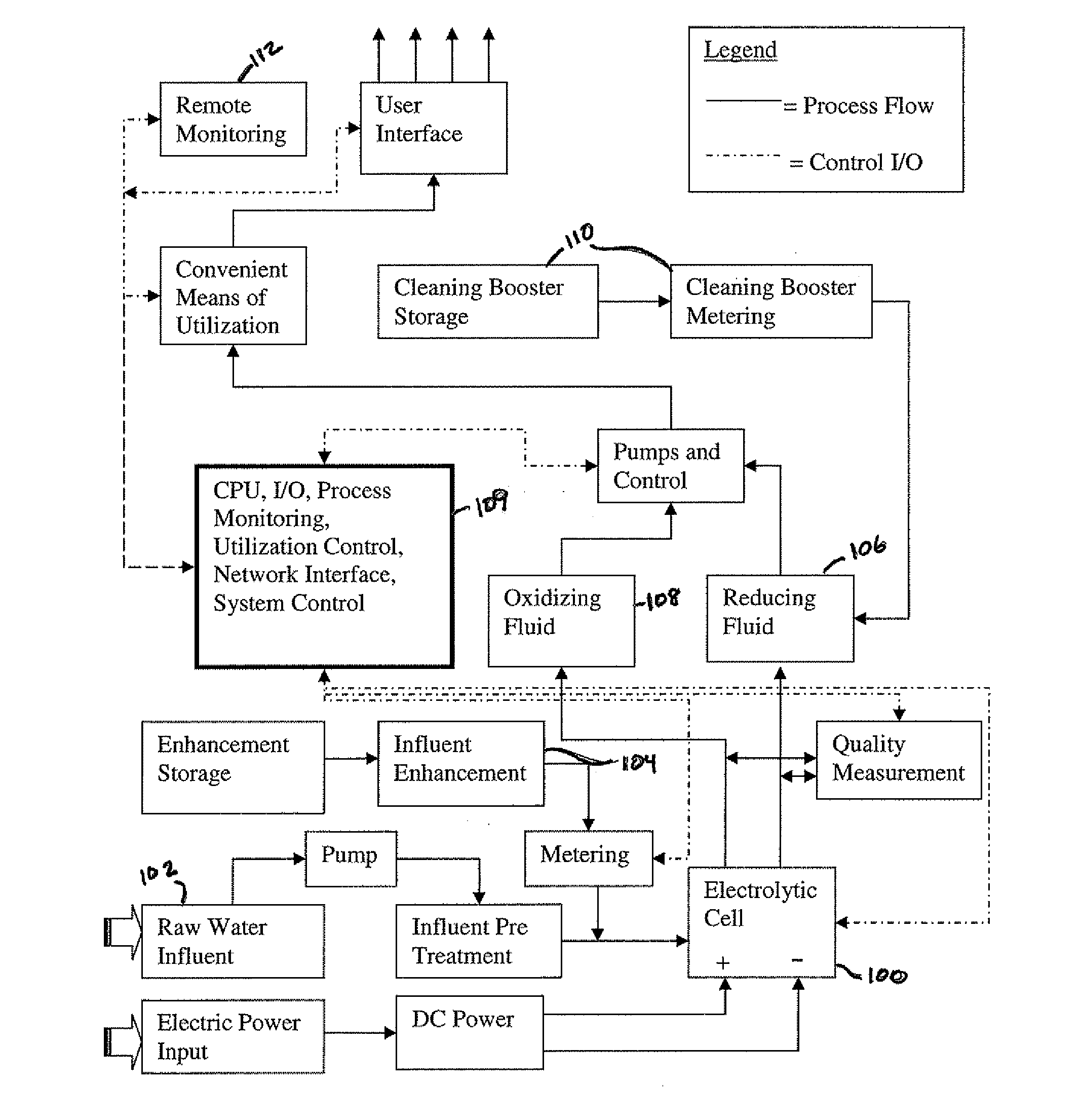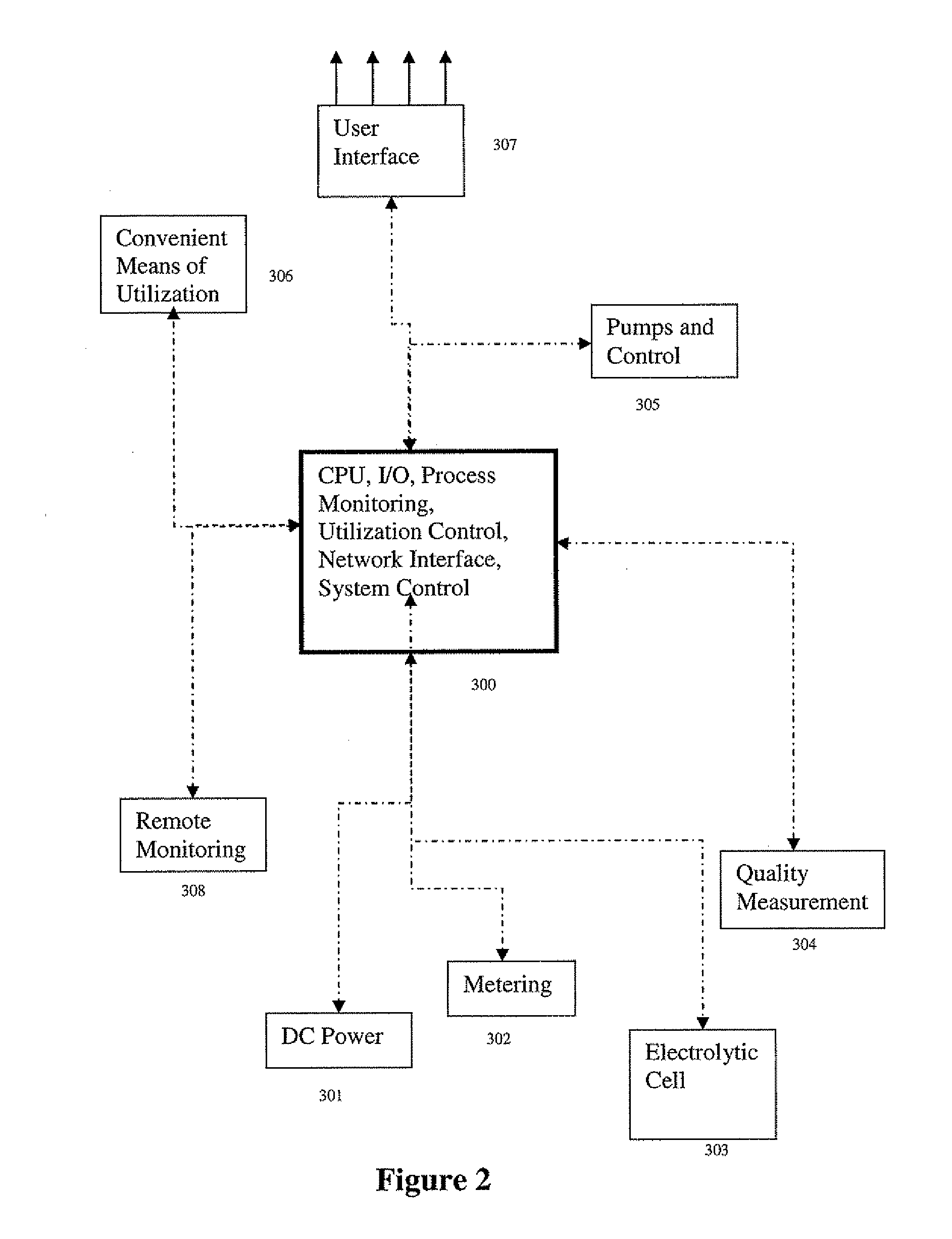[0011]Embodiments of the present invention act directly on the electrochemical charge balance between the
solid-liquid /
solid-
solid interface to reversibly alter the
electrochemical potential and overcome the technical impediments to efficiently clean a surface. The charged fluids generated, as described herein, directly modify the electrochemical properties of the contaminants to facilitate release of the contaminants and increase cleaning efficiency by controlling and overcoming the electrochemical charge that trapped, fixed, or adsorbed, the
contamination in place. Embodiments of the present invention utilize the electrochemical state of a
carrier fluid to address variations in bonding potential, and release the fluid and contaminants for improved and or selective cleaning efficiency. Easy manipulation of electronic potentials allows for utility to create a product that can be tailored to remove a wide range of pollutants that are attracted, and adsorbed, by varying electrostatic forces, A properly adjusted charged
carrier fluid will remove pollutants and prevent their reattachment (re-adsorption) to the surface being cleaned.
[0015]Embodiments herein include controlling the
electric potential of a solution by adjusting
current density,
total dissolved solids (TDS) and constituents,
electrode size and type, membrane type,
electric current,
voltage, fluid dwell time, or a combination of any of these or other variables. This allows a user to “tailor” a cleaning fluids'
electric potential so as to maximize efficiency for use on the task at hand. Embodiments of the present invention also provide predetermined compositions readily available at a filling port, e.g., to refill a squirt
bottle with glass cleaner. Other embodiments provide a control at a
user interface which can be used to “dial-in” a cleaner, pre diluted within the
system, to provide a cleaning material tailored for the task at hand.
[0016]Further, embodiments of the present invention generate powerful oxidizing fluids utilizing a variety of materials. The oxidation strength of the fluid can be modified as needed depending on the application requirement. Traditionally
chlorine, or a chlorinated compound, is typically used as a
disinfectant due to availability, cost and utility, (has been proven to kill 99% of the organisms and pathogens that cause
disease and illness).
Chlorine,
oxygen,
ozone, and even
quaternary ammonium compounds are all chemicals used as oxidizers to remediate biological contaminants. These compounds oxidize, or “steal”, electrons from the
cell wall of biologic substances thereby making them effective sanitizers. In terms of microbial action, an oxidizer pulls electrons away from the pathogenic
cell membrane causing it to become destabilized and leaky. Destroying the integrity of the
cell membrane leads to rapid cell death. Oxidizers then continue to oxidize, or “burn” up, the biologic remains leaving simplified organic residues which are no longer pathogenic and harmlessly rinsed away into the waste
effluent. For this reason, oxidizers are also effective at killing viral pathogens as well. An effective
chlorine oxidizer in a
chlorine sanitizer is
hypochlorous acid, HOCl. As such, embodiments herein include oxidizing cleaning and / or sanitization fluid having a tailored
electric potential.
[0019]Embodiments of the invention also include adjustment and control of the carrier fluid pH, eH, and / or
redox potential to improve efficiency of the disinfection process. As the reducing potential of compositions increase, a greater pH of the carrier fluid is required. Conversely, the lower the reducing potential (increased oxidizing potential) used, typically the lower the pH of the carrier fluid required. Using an appropriately
charged fluid in conjunction with other components, added to address specific removal requirements, significantly improves contaminant removal efficiency.
[0020]
Post injection of various cleaning boosters, surfactants, sequestering agents and / or other compounds to adequately address various aspects of the mechanisms required for cleaning is readily accomplished herein. The addition of cleaning boosters may be required to address and assist capillary penetration where contaminants are entrapped by
imbibition of the contaminant into the texture and micro-pores of the surface being cleaned. Boosters may be used to reduce
surface tension or increase the
wetting phase wettability thus creating a low
contact angle at the solid-
liquid interface. This allows the
wetting phase to penetrate into subsurface capillaries, and deliver the charge from the electrochemically altered fluid to satisfy and release the electrostatic bonding potential of the contaminant.
[0022]Finally, compositions and methods disclosed herein control the electrochemical state of a treated surface without the introduction of expensive, complex, or toxic synthetic chemicals thus reducing overall cost and logistical requirements. By providing compositions and methods herein for cleaning or sanitizing a surface we can create a means or apparatus utilizing compositions and methods to produce safe cleaning and disinfecting materials on site, conveniently at the point of use. Using embodiments of the present invention we can maintain the
hygiene of our personal and public environments in a sustainable way without sacrificing the natural balance and health of the global environment. This unique and unexpected approach allows for
environmentally friendly cleaning to be conducted safely, utilizing the molecular mechanisms which hold contaminants to the surfaces people come into contact with every day at a lower cost than current conventional methods thus significantly advancing the state-of-the-art.
 Login to View More
Login to View More 


